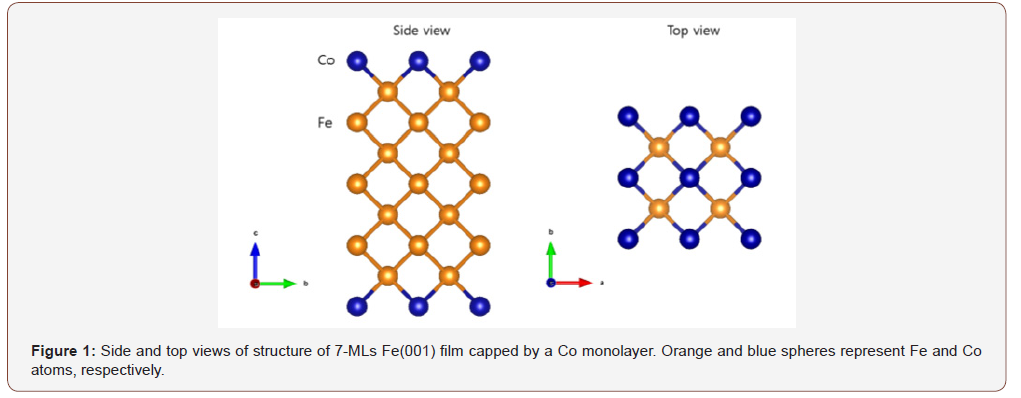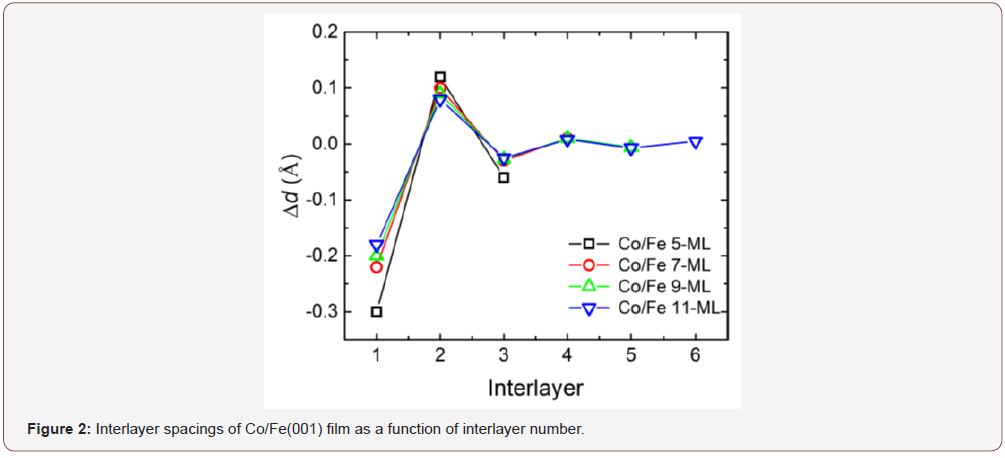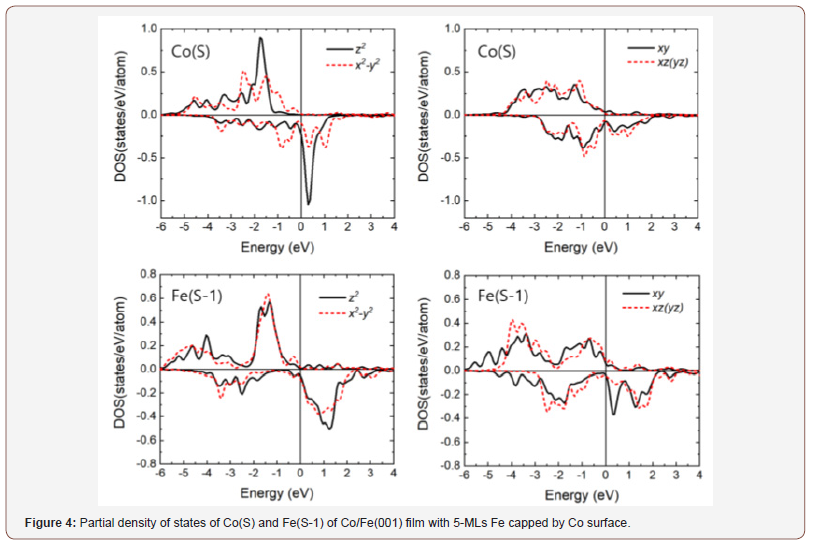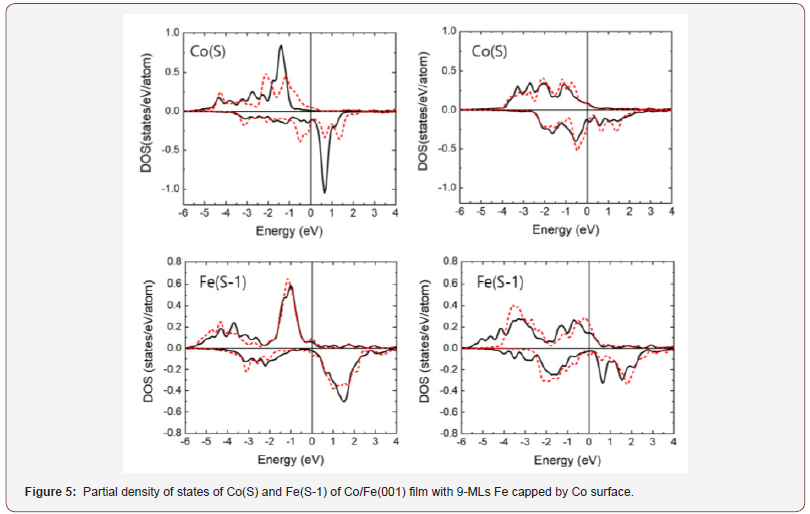 Research Article
Research Article
Magnetism and Magnetocrystalline Anisotropy of Co/ Fe(001) Surface: A First Principles Study
Soyoung Jekal* and Andreas Danilo
Laboratory of Metal Physics and Technology, Department of Material science, ETH Zurich, Switzerland
Soyoung Jekal, Laboratory of Metal Physics and Technology, Department of Material science, ETH Zurich, Switzerland.
Received Date: November 05, 2019; Published Date: November 15, 2019
Abstract
Recent theoretical calculations predicted that a magnetic thin film composed exclusively of 3d transition metals without heavy metals or rare earth metals can have strong perpendicular magneto crystalline anisotropy (MCA) in case 3d transition metals such as Fe, Co and Ni layers are arranged appropriately. While previous researches considered only Fe-terminated surfaces and found that Fe/MgO(001) and CoFeB/MgO(001) show strong perpendicular MCA, we investigate magnetism and MCA of Co/Fe(001) film where Co layer is positioned at the surface, by using the first principles calculation. Since the magnetic moments of Co and Fe are enhanced due to strong hybridization between Co and Fe d-bands, Co capped system also should be carefully considered. MCA of Co/Fe(001) is perpendicular to the film surface regardless of film thickness, which implies the surface termination as well as the interface play a crucial role in determining MCA of a system.
Introduction
Materials with strong perpendicular magnetic anisotropy have drawn attention in the field of the storage media such as magnetic random-access memory since it is essential to increase the writing/ reading speed and improve memory density [1-9]. To obtain strong perpendicular magnetic anisotropy, 4 and 5d heavy transition metal or rare-earth elements with large spin-orbit coupling have been generally used [10-12]. However, 4 and 5d transition metals as well as rare-earth metals are not abundant, therefore, intense research has been now actively conducted to improve perpendicular magnetic anisotropy without using heavy and rare-earth metals [13,14].
According to several theoretical calculations about magnetic thin film composed of only 3d transition metals, it also can have an enough perpendicular magnetic anisotropy energy in case orbitals of dx2-y2 and dxy are placed close to the Fermi level by adjusting film layers [13]. So far, most studies have focused on Fe surface since the strong perpendicular magnetic anisotropy was discovered in Fe/ MgO(001) and CoFeB/MgO(001) film systems. However, not only Fe surfaces but also other 3d transition metal surfaces should be carefully considered because extremely induced magnetic moment was predicted in Ni or Co surface with Fe(001) substrate due to a strong band mixing at the interface [15,16].
In present paper, we investigate magnetism and magneto crystalline anisotropy (MCA) of Co/Fe(001) films with different Fe thickness, from 5- to 17-ML to provide information on how to construct a system to obtain strong magnetic anisotropy in 3d transition metal compounds (Figure 1).
Methods
For density functional theory calculations, we use Vienna ab initio simulation package (VASP) [17-19] and Elk [20] in complementary relations. In the VASP calculation, the pseudopotential is generated by the projected augmented wave method [21]. Generalized gradient approximation is employed for the exchange-correlation potential [22]. A 12×12×1 mesh is used for k summation. For wave function expansion, energy cut-off of 500 eV is used. In the calculation with Elk, the wave functions were expanded into spherical harmonics with an angular momentum quantum number lmax=12 inside the non-overlapping spheres surrounding the muffin-tin spheres. A plane-wave cutoff of rgkmax=9 which sets the maximum length for G+k vectors, was used for the expansion of wavefunctions inside the interstitial regions.
While a film is composed of different thickness of Fe substrate (from 5- to 17-monolayers (MLs)) and 1-ML Co surface as shown in Figure 1, in-plane lattice constant of the film is fixed as value of bulk Fe (2.8665 Å), where internal coordinates are fully relaxed within force criteria of 1 meV/Å. To minimize artificial interaction between neighboring slabs, vacuum spacing of 20 Å is adopted between adjacent layers

Results And Discussions
Atomic structures
We calculate the changes of the interlayer distances after structure optimization as the following relationship, Δd=dj-i– d0, where d0 denotes the layer distance of the bulk Fe. From the calculated results depicted in Figure 2, we can infer that the interlayer distance decreases on the surface but increases in the layer just below the surface, then finally converges to a bulk value. For example, the interlayer spacing between the surface and subsurface layers of the Co/Fe(001) 11-ML film was calculated to be reduced by about 6.28% compared to the value of the bulk Fe. On the other hands, Δd of the centered layer is closed to zero. This oscillating trend corresponds to the interlayer behavior of a typical metal films.

Magnetic moment
The charge and spin density are the most basic physical quantities in a first principles study. Table 1 shows the magnetic moments of each atom, which are the result of the spin density calculated by Elk method.
As expected from previous studies of surfaces of magnetic thin films [15,23-25], significant magnetic moments are induced in the Co capping atoms, considering the experimentally observed and calculated magnetic moment of bulk Co is 1.65 and 1.49 μB, respectively. Table I presents the profile of the magnetic moment in a Fe(001) film capped by a Co monolayer, as determined by calculations for slabs of increasing Fe thickness. The Co surface, which is in direct contact to the Fe interface has the magnetic moment of about 1.83 μB, i.e., approximately 10% increased value
compared to the spin moment of bulk Co. Interface Fe(S-1) atoms also exhibit large magnetic moment over 2.3 μB, however, in the deeper Fe layers we find long-range oscillatory decaying magnetic moments.
Table 1: Calculated atomic-resolved magnetic moments of Co/Fe(001) with various Fe thickness, from 5-to 11-MLs. (S) and (S-n) denote the surface and the nth layer below the surface.

Magnetocrystalline anisotropy
The MCA energy is defined as the total energy difference between in-plane and perpendicular magnetizations to the film surface. According to perturbation theory [26], the MCA energy is due to spin-orbit coupling and defined as

Where ξ is the spin-orbit coupling constant. ο(u) and εο(u) represent eigenstate and eigenvalue of occupied (unoccupied) state, respectively.
As the denominator εu-εo becomes smaller, the MCA energy
becomes stronger. Therefore, the states near the Fermi energy
level play an important role in determining the MCA energy. As
can be seen from equation (1), the term contributes to
the perpendicular MCA while the
term contributes to
the perpendicular MCA while the term contributes to the
in- plane MCA energy. Therefore, if the orbital magnetic quantum
number of the o state is equal to the that of the u state, they lead
to the perpendicular MCA. However, a difference of 1 in the orbitalmagnetic quantum number between the o and u states lead to the
in-plane MCA. As a result, the perpendicular MCA is affected by
term contributes to the
in- plane MCA energy. Therefore, if the orbital magnetic quantum
number of the o state is equal to the that of the u state, they lead
to the perpendicular MCA. However, a difference of 1 in the orbitalmagnetic quantum number between the o and u states lead to the
in-plane MCA. As a result, the perpendicular MCA is affected by couplings, and the in-plane MCA can be expressed via
couplings, and the in-plane MCA can be expressed via couplings.
couplings.
Figure 3 presents the calculated MCA energies of the Co/ Fe(001) film as a function of the Fe thickness. The 5-MLs Fe(001) film capped by Co exhibits the lowest MCA energy of ∼0.10 meV. However, it increases monotonically with the Fe thickness, and reaches to ∼0.50 meV at 9-MLs Fe(001) covered by Co surface. After the MCA energy of Co/Fe(001) film shows a maximum value of about 0.50 meV at 9-MLs Fe(001), it is saturated to around to about 0.40 meV, as shown in Figure 3. The MCA energy behavior with respect to the Fe thickness indicates that the enhancement of the MCA energy comes purely from surface and interface effects. To investigate how the capping of a Co monolayer changes the electronic structure of the Fe(001) film and also why the values of MCA energy of 5-MLs and 9-MLs Co/Fe(001) are so different, we present density of states (DOS) of Co(S) and Fe(S-1) of 5-MLs and 9-MLs Co/Fe(001) films in Figure 4 and Figure 5.

Electronic structures
A single electron energy spectrum is analyzed to understand the magnetism and magnetic anisotropy of Co/Fe(001) film microscopically. Figure 4 and Figure 5 show the eg (z2, x2-y2) and t2g (xy, xz(yz)) states of Co(S) and Fe(S-1), which play a major role in determining the magnetic anisotropy of Co/Fe(001) films for the Fe thickness of 5-MLs (MCA energy : 0.110 meV) and 9-MLs (MCA energy : 0.475 meV), respectively. The majority spin states are almost filled for both Co(S) and Fe(S-1). Especially, this tendency is much clearly shown in the eg state. Therefore, the role of the majority spin states on magnetism, including magnetic anisotropy, is relatively limited. The DOS of minority spin states shows a complex shape compared to that of majority spin states, especially near the Fermi level.


Compared with the DOS of the CoFe system from Ref. [27,28,14], which showed the strong perpendicular MCA, the x2-y2 and xy states which because perpendicular MCA are placed close to the Fermi level in present Co/Fe(001) film systems. However, for 5-MLs Fe(001) film with Co capping (Figure 4), the z2 state in Co(S) is also closer to the Fermi level than that of 9-MLs Fe(001) film with Co capping (Figure 5). As can be seen from equation (1), the z2 state contributes only to the in-plane MCA. Furthermore, as shown in Figure 2, the surface interlayer distance of Co(S)- Fe(S- 1) for 5-MLs Fe(001) film is relatively narrow compared to that of 9-MLs Fe(001) film. As a result, the width of the z2 band becomes wider, while the x2-y2 and xy bands become narrower and higher. Therefore, Co capped Fe(001) 5-MLs film exhibit lower MCA energy, while the perpendicular MCA of 9-MLs Fe(001) film with Co surface reaches ∼0.5 meV.
Conclusion
In this study, the magnetism and magneto crystalline anisotropy of Co/Fe(001) film were calculated and analyzed by a first principle calculation method using VASP and Elk. When the in-plane lattice constant a = 2.796Å the magnetic moments of Co and Fe were increased to over ∼1.8 and 2.3 μB at the surface and the interface, respectively. Co/Fe(001) film was found to have perpendicular MCA regardless of the Fe thickness. Especially, the perpendicular MCA of 9-MLs Fe(001) film with Co surface reaches ∼0.5 meV. From the analysis of the electronic structures, we found that Co surface and Fe interface layers play a crucial role to determine MCA energy of the system.
Acknowledgements
None.
Conflict of Interest
No conflict of interest.
References
- Andrew D Kent (2010) Spintronics: Perpendicular all the way. Nat Mater 9(9): 699-700.
- Soyoung Jekal, Oryong Kwon, Soon Cheol Hong, Jae Il Lee (2015) Magnetocrystalline anisotropy of d0-magnetic material nan (001) thin films: A density functional study. J Nanosci Nanotechnol 15(3): 2356-2359.
- Soyoung Jekal (2019) Dependence of atomic thickness on interfacial conditions and Magnetocrystalline anisotropy in smco5/sm2co17 Materials (Basel) 12(1).
- S Ikeda, K Miura, H Yamamoto, K Mizunuma, HD Gan, et al. (2010) A perpendicular anisotropy CoFeB-MgO magnetic tunnel junction. Nat Mater 9(9): 721-724.
- RH Victora, Xiao Shen (2005) Composite media for perpendicular magnetic recording. IEEE Transactions on Magnetics, 41(2): 537-542.
- B Dieny, M Chshiev (2017) Perpendicular magnetic anisotropy at transition metal/oxide interfaces and applications. Reviews of Modern Physics 89(2): 025008.
- QL Ma, XM Zhang, T Miyazaki, S Mizukami (2015) Artificially engineered Heusler ferrimagnetic superlattice exhibiting perpendicular magnetic anisotropy. Scientific reports 5: 7863.
- Soyoung Jekal, SH Rhim, Soon Cheol Hong, Won-joon Son, Alexander B Shick (2015) Surface-termination-dependent magnetism and strong perpendicular magnetocrystalline anisotropy of an FeRh (001) thin film. Physical Review B 92(6): 064410.
- Soyoung Jekal, SH Rhim, Oryong Kwon, Soon Cheol Hong (2015) Thickness effect on magnetocrystalline anisotropy of Co/Pd (111) films: A density functional study. Journal of Applied Physics 117(17): 17E105.
- Dorj Odkhuu, SH Rhim, Noejung Park, Kohji Nakamura, Soon Cheol Hong (2015) Jahn-teller driven perpendicular magnetocrystalline anisotropy in metastable ruthenium. Physical Review B 91(1): 014437.
- DD Lam, F Bonell, S Miwa, Y Shiota, K Yakushiji, et al. (2013) Composition dependence of perpendicular magnetic anisotropy in Ta/Co x Fe 80-x B 20/MgO/Ta (x=0, 10, 60) multilayers. Journal of Magnetics 18(1): 5-8.
- SY Jekal, JF Loeffler, M Charilaou (2018) Pushing the limits of magnetic anisotropy in the Sm-Co system. arXiv preprint arXiv:1807.09257.
- K Hotta, K Nakamura, T Akiyama, T Ito, T Oguchi, et al. (2013) Atomic-layer alignment tuning for giant perpendicular magnetocrystalline anisotropy of 3 d transition-metal thin films. Phys Rev Lett 110(26): 267206.
- Eun Gu Kim, So Young Jekal, Oryong Kwon, Soon Cheol Hong (2014) Magnetism and magnetocrystalline anisotropy of CoFe thin films: A first-principles study. Journal of the Korean Magnetics Society 24(2): 35-40.
- M Tischer, O Hjortstam, D Arvanitis, J Hunter Dunn, F May, et al. (1995) Enhancement of orbital magnetism at surfaces: Co on Cu(100). Phys Rev Lett 75(8): 1602-1605.
- JI Lee, Soon C Hong, AJ Freeman, CL Fu (1993) Enhanced surface and interface magnetism of bcc Ni overlayers on Fe (001). Physical Review B 47(2): 810-817.
- Kresse G, Furthmüller J (1996) Efficient iterative schemes for ab initio total-energy calculations using a plane-wave basis set. Phys Rev B Condens Matter 54(16): 11169-11186.
- Kresse, J Furthmüller (1996) Efficiency of ab-initio total energy calculations for metals and semiconductors using a plane-wave basis set. Computational materials science 6(1): 15-50.
- G Kresse, D Joubert (1999) From ultrasoft pseudopotentials to the projector augmented-wave method. Physical Review B 59: 1758.
- The Elk Code.
- PE Blöchl (1994) Projector augmented-wave method. Physical Review B 50: 17953.
- John P Perdew, Kieron Burke, Matthias Ernzerhof (1996) Generalized Gradient Approximation Made Simple. Phys Rev Lett 77(18): 3865-3868.
- Fu CL, Freeman AJ (1987) Electronic and magnetic properties of the fcc Fe (001) thin films: Fe/Cu (001) and Cu/Fe/Cu (001). Phys Rev B Condens Matter 35(3): 925-932.
- AJ Freeman, Ru-quian Wu (1991) Electronic structure theory of surface, interface and thin-film magnetism. Journal of magnetism and magnetic materials 100(1-3): 497-514.
- Koon NC, Jonker BT, Volkening FA, Krebs JJ, Prinz GA (1987) Direct evidence for perpendicular spin orientations and enhanced hyperfine fields in ultrathin fe (100) films on ag (100). Phys Rev Lett 59(21): 2463-2466.
- Wang Ds, Wu R, Freeman AJ (1993) First-principles theory of surface magnetocrystalline anisotropy and the diatomic-pair model. Phys Rev B Condens Matter 47(22): 14932-14947.
- Jia Zhang, Christian Franz, Michael Czerner, Christian Heiliger (2014) Perpendicular magnetic anisotropy in CoFe/MgO/ CoFe magnetic tunnel junctions by first-principles calculations. Physical Review B 90(18): 184409.
- Shouzhong Peng, Mengxing Wang, Hongxin Yang, Lang Zeng, Jiang Nan, et al. (2015) Origin of interfacial perpendicular magnetic anisotropy in MgO/CoFe/metallic capping layer structures. Sci Rep 5: 18173.
-
Soyoung Jekal and Andreas Danilo. Magnetism and Magnetocrystalline Anisotropy of Co/Fe(001) Surface: A First Principles Study. Mod Concept Material Sci. 2(1): 2019. MCMS.MS.ID.000530.
-
Magnetism and Magnetocrystalline Anisotropy, Spin-orbit, Transition metals, Magnetic moments, Orbital magnetic quantum number
-

This work is licensed under a Creative Commons Attribution-NonCommercial 4.0 International License.






